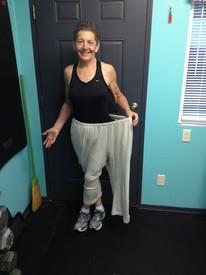Shin Splints

Bonny132
Posts: 3,617 Member
I am trying to take up running, so I am following the 5K Runner app, which I btw enjoy. My local gym staff is amazed that I apparently can run, for a beginner I am told I am doing really really well.
However, if I press myself a bit too hard (and here I do not mean torturing myself, just pressing myself over my comfortable level) my shins have a tendency to start hurting, so after a few weeks of running, my shins starts to hurt really badly, taking me back to walking level, instead of running level. (as in very slow running, but I am completing the current 5K programme for that particular week)
So as a result, I keep getting stuck on week 3-4. Any advice guys? I am already revisiting Runners World to test my gait again to ensure my trainers are correct for my usage.
Thank you all.
However, if I press myself a bit too hard (and here I do not mean torturing myself, just pressing myself over my comfortable level) my shins have a tendency to start hurting, so after a few weeks of running, my shins starts to hurt really badly, taking me back to walking level, instead of running level. (as in very slow running, but I am completing the current 5K programme for that particular week)
So as a result, I keep getting stuck on week 3-4. Any advice guys? I am already revisiting Runners World to test my gait again to ensure my trainers are correct for my usage.
Thank you all.
0
Replies
-
Slow down. Shin splints come (mostly) from going too fast, too far, too soon. Your lower legs haven't toughened up enough to handle the abuse. It's pretty common. If you keep agitating your shins, you can end up with stress fractures. Shin splints = weeks off. Stress fractures = months off.
Also, you can get them from running on concrete, and from poorly fitted shoes, or from shoes that have too many miles on them and have broken down internally.
The solution is to slow down. Back of the speed and/ or distance until they heal. Check your shoes too. Getting properly fitted by a running store (note - not a mega sports store) that records your gate on a treadmill is a huge benefit for preventing shin splints as well as other leg issues. Good luck!0 -
First of all thank you for your advice @RUN_LIFT_EAT much appreciated. My shoes are from a professional running store, where my gait was measured running outside on the pavement and again on the treadmill inside the store, and I got two pairs, one for outdoors (mostly pavements) and one for my gym treadmill.
When doing my 5K programme (I always restart at week 1) I can easily do at the intervals between 8-10mph on the treadmill, then I turn it down to 6.5 for the rest periods.
I do 4-5 weeks and the pain starts, my Gym (It is winter here so I run inside atm on the treadmill) instructors always tells me to push myself at my intervals to run as fast as I can, and always tells me I should push myself even harder. I do enjoy the running, I am just not a big fan of the pains I get after a while in my shins, and due to conflicting advice, here I am asking you guys, as I want to take up running as I quite enjoy it, apart from the shin pains that is.
My Last shoes were fitted 30 lbs ago, as in last year, at the running store, and the threads are all fine, both pairs looks good to me.0 -
First of all thank you for your advice @RUN_LIFT_EAT much appreciated. My shoes are from a professional running store, where my gait was measured running outside on the pavement and again on the treadmill inside the store, and I got two pairs, one for outdoors (mostly pavements) and one for my gym treadmill.
When doing my 5K programme (I always restart at week 1) I can easily do at the intervals between 8-10mph on the treadmill, then I turn it down to 6.5 for the rest periods.
I do 4-5 weeks and the pain starts, my Gym (It is winter here so I run inside atm on the treadmill) instructors always tells me to push myself at my intervals to run as fast as I can, and always tells me I should push myself even harder. I do enjoy the running, I am just not a big fan of the pains I get after a while in my shins, and due to conflicting advice, here I am asking you guys, as I want to take up running as I quite enjoy it, apart from the shin pains that is.
My Last shoes were fitted 30 lbs ago, as in last year, at the running store, and the threads are all fine, both pairs looks good to me.
There's a debate, but shoes are good from 250-400 miles (last I checked). Some shoes are built tougher. You can't judge by appearances. They break down structurally internally, and your support becomes compromised.
The mere fact you're dealing with shin splints tells me that your coaches are pushing you too hard. Just because your legs can push that hard doesn't mean your lower tibia can handle it.
I've dealt with them a dozen times in 25 years of running (off and on), and it's always from pushing too hard too soon. I would lay off the intervals until you're healed. Your coaches won't suffer if you get stress fractures... but you sure will! 0
0 -
@RUN_LIFT_EAT thank you for your response, my shoes are still OK as there is no way I have done those distances. I used to run a lot till my teens (boys ugh) when I stopped, and apparently my legs are way stronger than my trainers expected.(I am upping my leg presses every couple of weeks atm) I stopped doing my regular exercises when I was about 16ish? When I was pretty fit and fast, fast as in long distance fast not a sprinter. After I stopped till last year I was pretty inactive tbh and when I started my programme, I was told to at intervals to push myself to a 9 out of 10 which is what I am doing and suffering from.0
-
RUN_LIFT_EAT wrote: »Slow down. Shin splints come (mostly) from going too fast, too far, too soon. Your lower legs haven't toughened up enough to handle the abuse. It's pretty common. If you keep agitating your shins, you can end up with stress fractures. Shin splints = weeks off. Stress fractures = months off.
Also, you can get them from running on concrete, and from poorly fitted shoes, or from shoes that have too many miles on them and have broken down internally.
The solution is to slow down. Back of the speed and/ or distance until they heal. Check your shoes too. Getting properly fitted by a running store (note - not a mega sports store) that records your gate on a treadmill is a huge benefit for preventing shin splints as well as other leg issues. Good luck!
+1. If you're progressing too quickly you'll spend part of your run in bad form (survival form).
Back off. Check your shoes at a local running store as described above. Tell them you're having shin splints. Ask them to look at your gait and your form in general.
Good luck!0 -
There are some stretches that helped me with shin splints. I got them when I started my walking program. No problem now, walking or running.0
-
Research compression leg sleeves- they work wonderful at helping prevent shin splints.0
-
.... between 8-10mph on the treadmill,
Slow down, if you're running at that pace your gait will be contributing to shin splints, on top of the too much, too soon aspect.
It sounds like the gym staff are pushing you too hard.
fwiw I'll do most of my training runs at around 6-7 mph, working at half marathon and marathon.My Last shoes were fitted 30 lbs ago, as in last year, at the running store, and the threads are all fine, both pairs looks good to me.
Which means that you've been using them for non running activities?
Your shoes are probably contributing to the problem, and it's time to get new ones.
Running shoes have a life of between 300 and 500 miles, and should only be used for running.
0 -
christyg74 wrote: »Research compression leg sleeves- they work wonderful at helping prevent shin splints.
There is no compelling evidence that compression sleeves help whilst running and may have a placebo effect only in recovery.
0
This discussion has been closed.
Categories
- All Categories
- 1.4M Health, Wellness and Goals
- 398.5K Introduce Yourself
- 44.7K Getting Started
- 261K Health and Weight Loss
- 176.4K Food and Nutrition
- 47.7K Recipes
- 233K Fitness and Exercise
- 462 Sleep, Mindfulness and Overall Wellness
- 6.5K Goal: Maintaining Weight
- 8.7K Goal: Gaining Weight and Body Building
- 153.5K Motivation and Support
- 8.4K Challenges
- 1.4K Debate Club
- 96.5K Chit-Chat
- 2.6K Fun and Games
- 4.8K MyFitnessPal Information
- 18 News and Announcements
- 21 MyFitnessPal Academy
- 1.5K Feature Suggestions and Ideas
- 3.2K MyFitnessPal Tech Support Questions




